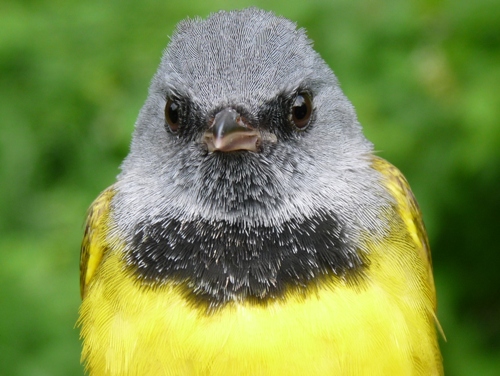|
|
THIS WEEK |
THIS SPRING |
2011 TOTAL |
SITE TOTAL |
|
# birds (and species) banded |
198 (38) |
622 (53) |
693 (57) |
32262 (107) |
|
# birds (and species) repeat |
26 (12) |
71 (20) |
79 (20) |
5586 (68) |
|
# birds (and species) return |
15 (7) |
49 (17) |
73 (16) |
880 (37) |
|
# species observed |
98 |
129 |
133 |
202 |
|
# net hours |
279.0 |
1790.0 |
1813.0 |
51430.1 |
|
# birds banded / 100 net hours |
71.0 |
34.7 |
38.2 |
62.7 |
|
|
Note: table does not include nocturnal banding (owls) |
Banders-in-charge: Simon Duval, Gay Gruner, Lance Laviolette
Intern: Matthew Von Bornhoft
Assistants: Christine Barrie, Nicolas Bernier, David Davey, Rui De Jesus, Sarah Dixon, Meghan Laviolette, Francine Marcoux, Barbara MacDuff, Betsy McFarlane, Pierre Molina, Chris Murphy, Benoit Piquette, Patricia Stotland
Notes: The low-pressure system that moved in late last week remained in place for the first half of this week too. Banding was completely washed out for four straight days (Saturday of last week continuing through Tuesday of this week), the first time in our history that weather has caused such a long gap in our operations. Of course our dedicated censusers still proceeded with their counts daily, and they got good results, with an average of 45 species over those four days. However, knowing such a diversity of species was present around the peak of migration made it all the more unfortunate that we could not open the nets. This latest stretch of rain has caused the back pond to rise high enough to put net H1 out of commission again due to flooding. That's not surprising, given that by May 15, the rainfall for the month was already several millimetres more than the average for all of May, and more than double what was recorded in the full month last year.
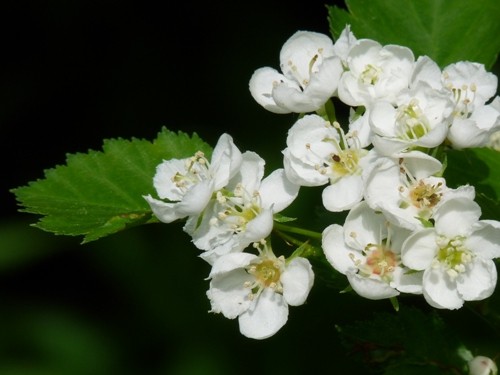
Although all the rain is a bit frustrating for our bird work, the vegetation is thriving, with our hawthorns in full blossom, as well as our many apple trees.
(Photo by Marcel Gahbauer)
|
Despite that gloomy introduction, we had plenty of noteworthy observations this week, as usual. On Tuesday a Mourning Warbler was heard singing in the rain, and it remained present for the rest of the week, leading us to wonder whether it might consider breeding at MBO. The same day, a Green Heron was seen at close range in the sumacs near the C nets, and an American Bittern was seen in a rather odd place, along the path between the D and E nets. It too hung around for much of the week, and we are curious whether the higher than usual water level in the ponds will tempt it to stay for summer. Other highlights of the week included a singing Pine Siskin near net D2, and the group of 6 Bobolinks continuing to hang out together and sing in the field.
As much as we lament the rain for shutting us down on many days, it may actually have been to our advantage by concentrating the movement of northbound migrants. By the time we were able to operate regular net hours on Friday and Saturday we banded decent numbers for spring (30 and 33 respectively), and then on Sunday we shattered the single-day spring record of 67 birds banded (set May 20, 2009) by over 50%, with 102 birds of 26 species banded (the previous spring record was 22 species, on the same date in 2009), plus another 10 recaptures. The total number banded this spring is now 617, slightly ahead of the previous best at the end of week 8 (602 in 2006).
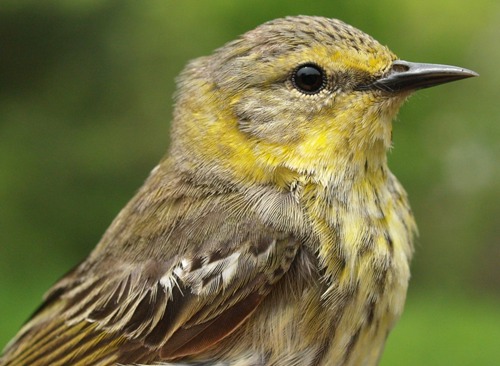
Cape May Warbler (e.g. above) and Bay-breasted Warbler (e.g. below) are among the rarest warblers at MBO in spring; in both cases these were the fifth of their kind banded over our seven years of Spring Migration Monitoring.
(Photos by Simon Duval)
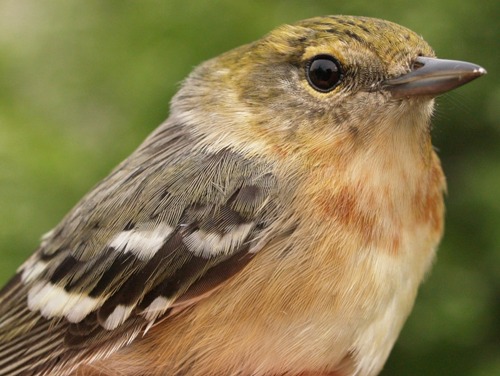
|
Many of the mid/late spring migrants made their first appearances this week, along with a couple of uncommon species that we don't record every spring. The pleasant surprises were Great Egret (only our second record ever) and Peregrine Falcon (seen for the fourth time in seven spring seasons), while the annual visitors making their return were American Bittern, Traill's Flycatcher, Eastern Wood-Pewee, Red-eyed Vireo, Orange-crowned Warbler, Canada Warbler, Wilson's Warbler, and Mourning Warbler. We also added 9 species to the list of birds banded this spring, bringing the cumulative total to 53 species, which is slightly below average for this point in the season. The new additions this week were Northern Parula, Cape May Warbler, Bay-breasted Warbler, Ovenbird, Wilson's Warbler, Canada Warbler, Rose-breasted Grosbeak, Baltimore Oriole, and Pine Siskin. This week the only new return species for the year was Gray Catbird. Among the individual returns of interest were a Veery banded on August 27, 2008, and a Yellow Warbler that we have recaptured every spring since banding it in May 2007.
This week’s
top 10
#
individuals banded |
mean # individuals observed daily |
1. Yellow-rumped Warbler (48) [2] |
1. Red-winged Blackbird (48) [2] |
2. Tennessee Warbler (23) [-] |
2. Yellow-rumped Warbler (26) [3] |
3. Red-winged Blackbird (13) [1] |
3. American Crow (15) [5] |
4. Common Yellowthroat (10) [3] |
4. Ring-billed Gull (14) [4] |
5. Blackpoll Warbler (8) [-] |
5. Cedar Waxwing (13) [7] |
5. Magnolia Warbler (8) [8] |
6. Yellow Warbler (12) [-] |
5. Northern Waterthrush (8) [-] |
7. Baltimore Oriole (11) [-] |
8. American Redstart (7) [-] |
8. Canada Goose (10) [1] |
8. Baltimore Oriole (7) [-] |
9. Tree Swallow (9) [8] |
10. Nashville Warbler (6) [-]
10. Yellow Warbler (6) [5]
|
10. American Goldfinch (9) [10] |
|
For a second week in a row there was a considerable amount of change in the top ten list of species banded. Yellow-rumped Warbler took over top spot, a first for the species at any point in spring, though of course it is often the most abundant species by far in falI. In second place was Tennessee Warbler, which had been number one in this week back in 2009, and number two in 2007, but has missed the top ten in all other years (another two-year pattern appears to be emerging, like the oscillation of Yellow-rumped Warblers in fall). Warblers were dominant this week, taking all but two spots in the list, with Red-winged Blackbird and Baltimore Oriole being the only exceptions. Whereas the blackbird is always in the top 10 at this time of year, the oriole has only cracked the list in three of six previous years. Among the other seven warblers on this week's list, only Yellow, Magnolia, and Common Yellowthroat can be considered regulars in the top ten for week 8; Northern Waterthrush has been on the list in two previous years, Nashville Warbler in one, and this marks the first appearance of Blackpoll Warbler and American Redstart this early in the season. The redstart count is particularly impressive, as previously we had never banded more than 6 in an entire spring season, even though it is a much more common fall migrant.
Canada Goose finally dropped out of top spot among species observed, tumbling all the way to 8th place, reflecting the departure of the last flocks of migrants. Red-winged Blackbird moved up to #1, where it has been in week 8 in three of six previous years. In top spot in the other years has been Ring-billed Gull, which was only the fourth most abundant species this week. Paralleling the record number of individuals banded this week, Yellow-rumped Warbler, an unprecedented mean daily count propelled it into second place. Cedar Waxwing moved up into the top 5 this week, but only a couple of them ended up getting banded. Tree Swallow and American Goldfinch remained near the bottom of the list, while Black-capped Chickadee and White-throated Sparrow dropped out this week, displaced by increasing numbers of Yellow Warblers and Baltimore Orioles.
|
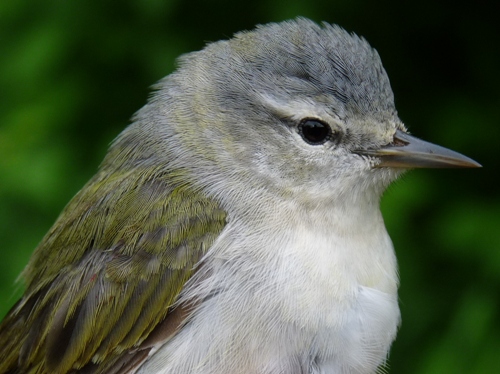
Like in spring 2009, we are experiencing a big influx of Tennessee Warblers, with three times as many banded this week as all of last spring. This provides a great opportunity to compare between ages and sexes. Side by side, the distinctly gray cap of males (such as the one above) is quite different from the more greenish crown of females (such as the one below).
(Photos by Marcel Gahbauer)
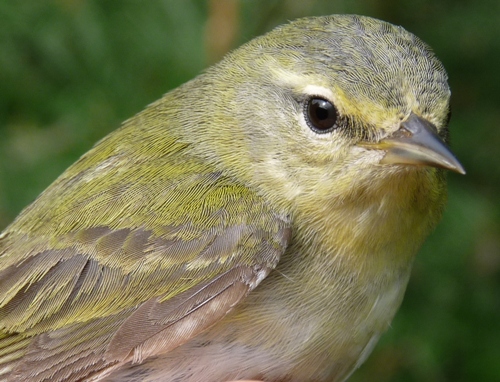
|

